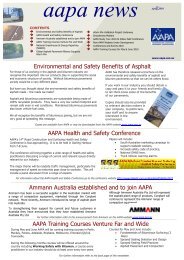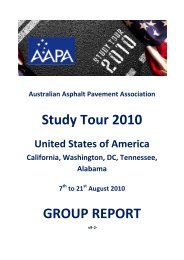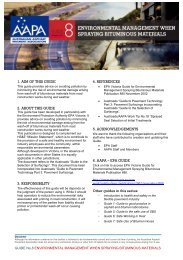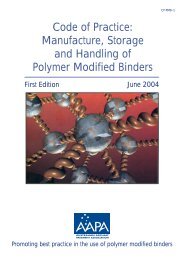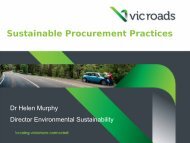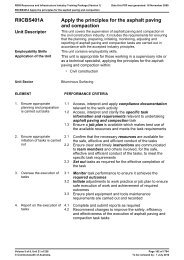Asphalt Review - Volume 29 Number 2 (June / July 2010)
Asphalt Review - Volume 29 Number 2 (June / July 2010)
Asphalt Review - Volume 29 Number 2 (June / July 2010)
You also want an ePaper? Increase the reach of your titles
YUMPU automatically turns print PDFs into web optimized ePapers that Google loves.
ASPHALT REVIEW<br />
occur over time. However, such rate of softening is mainly<br />
determined by the stiffness of the support, which determines<br />
the degree of shear in the layer. However, owing to the higher<br />
cohesive strength, these layers are less sensitive to the support<br />
stiffness than unbound granular materials (higher modular ratio<br />
limit).<br />
Table 3 summarises the limits applicable to the modular ratio<br />
and maximum stiffness rules.<br />
Condensed version - full version available from Conference<br />
papers 2009 - aapa@asn,com.au<br />
Designing pavement using the PN method<br />
See full paper - Condensed version - full version available from<br />
Conference papers 2009 - aapa@asn,com.au<br />
The beauty of this method lies in its simplicity. The procedure<br />
commences by defining the pavement structure in terms of layer<br />
thickness and material class for each component layer.<br />
ECONOMIC AND ENVIRONMENTAL<br />
BENEFITS<br />
The benefits of using BSMs in pavement structures were shown<br />
by comparing different options for the rehabilitation of a specific<br />
pavement, each with the same structural capacity. The three<br />
options selected (illustrated in Figure 4) represent different<br />
technologies.<br />
Option 1 calls for the distressed asphalt layers to be removed<br />
by milling, the upper portion of the underlying base repaired<br />
before replacing the asphalt with fresh material.<br />
Option 2 reuses the existing pavement layers, recycled with<br />
cement as a new subbase layer.<br />
Option 3 reuses the existing pavement layers recycled with<br />
bitumen as a new BSM base layer, requiring only a relatively<br />
thin asphalt wearing course. .<br />
Economic comparison<br />
An estimate of the type and extent of maintenance work<br />
during a 20-year service life suggested that the asphalt<br />
surfacing layer would need replacing every seven to eight<br />
years for all options. Being susceptible to moisture ingress,<br />
an extra 35mm thickness of asphalt would be needed for<br />
Option 2 after some 14 years. Then, at the end of the service<br />
life, rehabilitation measures were determined, based on the<br />
failure condition of the various pavements:<br />
Option 1 (failure condition: fatigue cracks through the full<br />
thickness of asphalt over 10% of the length). Rehabilitate by<br />
applying a 60mm thick asphalt overlay plus a new asphalt<br />
surfacing;<br />
Option 2 (failure condition: moisture activated distress<br />
of the graded crushed stone base with potholes affecting<br />
10% of the road length). To be recycled to create a BSM<br />
base layer plus an asphalt surfacing (similar to the original<br />
rehabilitation Option 3);<br />
Option 3 (failure condition: permanent deformation of<br />
20mm in 10% of the total length of wheel paths). This can<br />
be addressed by milling off the asphalt surfacing, paving a<br />
levelling layer (35mm nominal thickness) and replacing the<br />
asphalt surfacing.<br />
Construction costs tend to be country specific and, in<br />
some cases, regional specific. A comparison of construction<br />
costs in money terms is therefore not a satisfactory means of<br />
comparing the three options. Determining the unit cost per<br />
kilometre for the life cycle (rehabilitation to rehabilitation)<br />
and reducing cost to a relative index does, however, provide a<br />
unit free basis for comparison. Accordingly, each option was<br />
priced using average unit contract rates in the South African<br />
construction industry (expressed in US$) and divided by the<br />
cost of Option 1 to obtain an index, as shown in Table 4.<br />
This exercise indicates that recycling with a bitumen<br />
stabilising agent is some 30% more cost efficient than the<br />
other two options where the initial rehabilitation called for<br />
a 20-year service.<br />
Energy consumption comparison<br />
The increased level of awareness of climate change is<br />
making society more aware of energy consumption. The<br />
construction industry is not exempt and several studies have<br />
been undertaken to estimate the amount of energy being<br />
consumed, particularly in the construction of roads where<br />
large machinery is employed and the quantities of material<br />
either consumed or moved is high.<br />
A detailed exercise carried out in New Zealand in 2008<br />
(Reference 8, Patrick) reported on the energy consumption<br />
data for various construction activities. Using this data, a<br />
similar exercise to that carried out above to determine costs<br />
was undertaken to estimate the total energy consumed for<br />
each option over a 20-year period. The results are shown in<br />
Table 5.<br />
This exercise indicates that combined construction activities<br />
over a 20-year cycle are almost 30% more energy efficient for the<br />
BSM option (Option 3) than Option 1 which, in turn, is some<br />
30% more energy efficient than Option 2.<br />
CONCLUSIONS<br />
The publication of TG2 Second Edition has provided a refreshing<br />
new insight into the behaviour of BSMs and introduced a new<br />
separate class of material for use in pavement structures.<br />
In recognising that the end product is similar regardless of<br />
whether the bitumen is applied in an emulsified or foamed<br />
state, this publication has effectively eliminated the conflict<br />
between the bitumen emulsion and foamed bitumen lobbies.<br />
In addition, TG2 Second Edition provides a relatively simple<br />
set of guidelines for the competent design and construction of<br />
pavements that include these materials.<br />
Maximising the reuse of existing pavement materials by<br />
recycling minimises the consumption of new materials,<br />
thereby providing both economic and environmental<br />
benefits. The addition of a bitumen stabilising agent<br />
enhances the performance of the recycled material, providing<br />
both flexibility and durability. Due to their durability<br />
properties, BSMs offer a lower whole-of-life cost through<br />
lower maintenance and other interventions required to<br />
achieve an acceptable level of service over the design life of<br />
the pavement, as well as the cost of rehabilitation when the<br />
terminal condition is reached. The true value of BSMs is only<br />
now starting to receive the attention they deserve. Meanwhile,<br />
environmental considerations are receiving more attention<br />
in the provision of pavements, a long overdue focus brought<br />
about by global concerns over climate change. Increasing<br />
emphasis on the environmental impact of road construction<br />
and rehabilitation has led to sufficient data becoming<br />
available for use in analysis and decision making. Decisions<br />
based solely on initial construction costs will, in future, be<br />
replaced by a more complex model that incorporates both<br />
energy consumption and whole-of-life costs.<br />
32 ROADS JUNE <strong>2010</strong>/JULY <strong>2010</strong>



